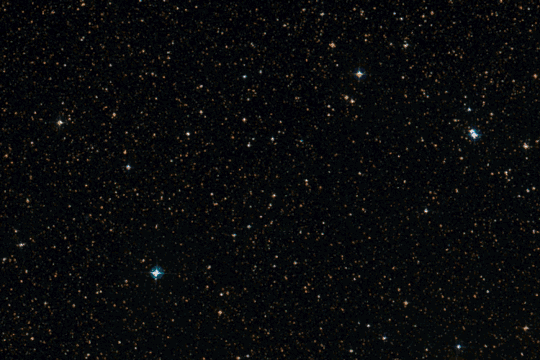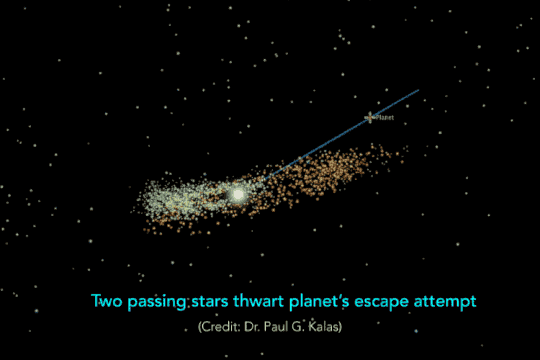The sheer range of possible outcomes in a planetary system is something we’re beginning to appreciate with each new exoplanet. Not long ago we looked at a possible collision between two large worlds in the young system Kepler 107, and the knowledge of how violent an evolving system can be informs our thinking about the formation of our own Moon and other Solar System phenomena. Now we’re learning to look for signs of another kind of early cataclysm, the migration of a planet caused by the close passage of one or more nearby stars.
None of this should be surprising when we think about the outer system today. We have a vast cloud made up of trillions of comets encircling a more disk-like belt of debris in the Kuiper Belt, and a host of small objects moving on orbits that challenge our theories of how they formed. Indeed, the orbits of ‘scattered disk’ objects influenced by Neptune and, even more intriguing, unusual trans-Neptunian objects like Sedna may implicate a yet undiscovered planet 9.
Some of what we are seeing may well be the result of a star passing near the Sun, and we know, for example, that the binary system known as Scholz’s star (WISE 0720?0846) passed through the Oort Cloud some 70,000 years ago. Close passes much earlier in the evolution of our protoplanetary disk could obviously have played a role in disrupting existing orbits.
An F-class star in the constellation Crux about 300 light years from Earth, HD 106906 may hold promising information about just such an event in another stellar system. The star is orbited by a directly imaged planet in a misaligned orbit that has been under investigation by UC-Berkeley’s Paul Kalas, working with Robert De Rosa (Kavli Institute for Particle Astrophysics and Cosmology). With a mass of about 11 Jupiters, the planet is tilted 21 degrees from the plane of the circumstellar disk. It’s also a whopping 738 AU out, 18 times farther from its star than Pluto from the Sun. That brings into doubt its in situ formation.

Image: Two binary stars, now far apart, skated by one another 2-3 million years ago, leaving a smoking gun: a disordered planetary system (left). Credit: UC-Berkeley. Credit: Paul Kalas.
A closer look using the Gemini Planet Imager and the Hubble Space Telescope produced the finding that this star is orbited by a belt of comets in an equally lopsided orbit. The signs of disruption were clear, and Kalas and De Rosa trace out a tortured history for this unusual world. Through gravitational instability induced by too close a passage to the central binary star (a finding discussed by Grenoble Observatory researchers led by Laetitia Rodet in 2017), the planet would have gone interstellar but for the close passage of a pair of passing stars. Their gravitational influence left it in the remote outer regions of its system on an eccentric orbit.

Image: Simulation of a binary star flyby of a young planetary system. UC Berkeley and Stanford astronomers suspect that such a flyby altered the orbit of a planet (in blue) around the star HD 106906 so that it remained bound to the system in an oblique orbit similar to that of a proposed Planet Nine attached to our own solar system. Animation credit: Paul Kalas.
Kalas and De Rosa used data from the European Space Agency’s Gaia mission to firm up this hypothesis. The scientists collected information on 461 stars from Gaia DR2 astrometry, all of them in the stellar grouping known as the Scorpius–Centaurus (Sco–Cen) association. Incorporating ground-based radial velocity work as well, the team calculated the positions of these stars backward in time, revealing the binary stars — HIP 59716 and HIP 59721 — as candidates for the stars that altered the young system some 3 million years ago.
“What we have done here is actually find the stars that could have given HD 106906 b the extra gravitational kick, a second kick so that it became long-lived, just like a hypothetical Planet Nine would be in our solar system,” Kalas said.
“Studying the HD 106906 planetary system is like going back in time to watch the Oort cloud of comets forming around our young sun. Our own giant planets gravitationally kicked countless comets outward to large distances. Many were ejected completely, becoming interstellar objects like ?Oumuamua, but others were influenced by passing stars. That second kick by a stellar flyby can detach a comet’s orbit from any further encounters with the planets, saving it from the prospect of ejection. This chain of events preserved the most primitive solar system material in a deep freeze far from the sun for billions of years.”
Image: Some 2 to 3 million years ago, in a young, newly formed planetary system, a planet was in danger of being kicked out of the system because of gravitational interactions with the central, binary star (left panel). A close pass by another binary star (not shown) within the same cluster gave the planet an extra kick that stabilized the orbit and rescued it from certain ejection (right panel). Credit: Paul Kalas.
The binary pair came into the system disk of HD 106906 on a trajectory that was within 5 degrees of the system disk, maximizing the extent of the encounter. From the paper:
HIP 59716 and HIP 59721 are the best candidates of the currently known members of Sco–Cen for a dynamically important close encounter with HD 106906 within the last 15 Myr. The flyby of these two stars fulfill many of the criteria for the stabilization scenario described in Rodet et al. (2017). Their trajectories are almost coplanar with the debris disk in its current orientation, their velocities relative to HD 106906 at closest approach are low (the change in velocity of the orbiting planet being inversely proportional to the relative velocity of the passing star at closest approach), and the distribution of closest approach distances for HIP 59716 is consistent with a dynamically significant encounter within 0.5 pc.
Continuing work on this system will investigate the relative radial velocities of the stars involved, which will mean future spectroscopic studies of the two candidate perturbers. The authors point out that the astrometry for each star will be improved with upcoming Gaia data releases. “We started with 461 suspects and discovered two that were at the scene of the crime,” says Kalas. “Their exact role will be revealed as we gather more evidence.”
The paper is De Rosa & Kalas, “A Near-coplanar Stellar Flyby of the Planet Host Star HD 106906,” accepted for publication at the Astronomical Journal (abstract).



Here’s another factor determining a planet’s long term habitability: It must be orbiting a star which has an orbit which manages to avoid very close encounters with other stars. Fortunately, the average distance between stars makes very close encounters very rare.
But, in small systems like around M dwarfs and late K dwarfs they generally have more compact planetary systems that would be less inclined to disruption. Notice that HD 106906 is an F-class star with a 11 mass Jupiter that are common in higher mass stars and as in our solar system have much larger orbits then systems like Trappist 1.
That is true. It will be the outer cold planets that will be most at risk from close stellar incursions.
Regarding instellar travel, maybe binary systems involving very heavy stars with very small distances between them could be used to slingshoot starships to very high velocities, or decelerate them? I realize it might take some time to reach one of these systems from here though :)
Interesting that you mention this, as it will be the subject of a series of posts starting next week.
That is very interesting. I wonder what kind of velocity transfer to a ship would be possible? Let’s hope it doesn’t happen to our solar system however. In this case the planet was “rescued” from leaving it’s orbit but I suspect it’s far more likely that a passing star would disrupt many orbits of planets.
That brings up the interesting question of determining the probability of stabilization versus the probability of ejection. Possibly, with a lot more effort surely, even the probability of stabilization into a livable orbit. I realize that would depend on the properties of the binaries, and if they were to merge soon in geological time it probably wouldn’t matter about livability. And I doubt any of this would be pertinent within a cluster.
Globular clusters, beside being very ancient, have high stellar densities.
If their stars formed circum-stellar disks, they must have been disrupted
very frequently. And if they survived long enough to form planets, then ejections must have been more commonplace than in the Galaxy at large.
Globular clusters are not always out of the galactic plane. Maybe some of the interstellar traffic in asteroids or comets originates from them?
Wikipedia says re globular clusters:
“Globular clusters can contain a high density of stars; on average about 0.4 stars per cubic parsec, increasing to 100 or 1000 stars per cubic parsec in the core of the cluster.[30] The typical distance between stars in a globular cluster is about 1 light year,[31] but at its core, the separation is comparable to the size of the Solar System (100 to 1000 times closer than stars near the Solar System).[32]
Globular clusters are not thought to be favorable locations for the survival of planetary systems. Planetary orbits are dynamically unstable within the cores of dense clusters because of the perturbations of passing stars. A planet orbiting at 1 astronomical unit around a star that is within the core of a dense cluster such as 47 Tucanae would only survive on the order of 10^8 years.[33]”
Since globular cluster diameters can span several tens of parsecs whenever one of them is crossing through the galactic disk there must be quite a few disk stars moving inside the globular during the cluster’s passage. This would make for some interesting times for dwellers on the planets of disk stars during such crossings!
I have heard it is rather difficult to maintain a working civilization in those star clusters. They keep having to start all over again every 2,049 years for some reason.
Hah! Wonderful reference.
There should be “delocalised planets” in globular clusters, there is a paper somewhere which says this.
Also, the stellar density towards the centre of the galaxy gives similar problems. It is only at several kpc radius that the rate of stellar encounters falls off sufficiently for complex life to evolve.